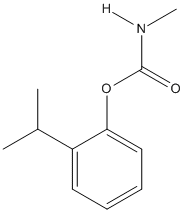Isoprocarb
General
Type : Insecticide,Carbamate
Chemical_Nomenclature : (2-propan-2-ylphenyl) N-methylcarbamate
Canonical SMILES : CC(C)C1=CC=CC=C1OC(=O)NC
InChI : InChI=1S\/C11H15NO2\/c1-8(2)9-6-4-5-7-10(9)14-11(13)12-3\/h4-8H,1-3H3,(H,12,13)
InChIKey : QBSJMKIUCUGGNG-UHFFFAOYSA-N
Other name(s) : Etrofolan,Mipcine,Mipcin,2-Isopropylphenyl N-methylcarbamate,O-Cumenyl methylcarbamate

Target
Families : Isoprocarb ligand of proteins in family
ACHE
References (5)
| Title : Identification of two acetylcholinesterases in Pardosa pseudoannulata and the sensitivity to insecticides - Zhang_2014_Insect.Biochem.Mol.Biol_46C_25 |
| Author(s) : Zhang Y , Shao Y , Jiang F , Li J , Liu Z |
| Ref : Insect Biochemistry & Molecular Biology , 46C :25 , 2014 |
| Abstract : Zhang_2014_Insect.Biochem.Mol.Biol_46C_25 |
| ESTHER : Zhang_2014_Insect.Biochem.Mol.Biol_46C_25 |
| PubMedSearch : Zhang_2014_Insect.Biochem.Mol.Biol_46C_25 |
| PubMedID: 24463359 |
| Gene_locus related to this paper: 9arac-v5qqc6 , 9arac-v5qqr1 |
| Title : Responses of AChE and GST activities to insecticide coexposure in Carassius auratus - Wang_2012_Environ.Toxicol_27_50 |
| Author(s) : Wang C , Lu G , Cui J |
| Ref : Environ Toxicol , 27 :50 , 2012 |
| Abstract : Wang_2012_Environ.Toxicol_27_50 |
| ESTHER : Wang_2012_Environ.Toxicol_27_50 |
| PubMedSearch : Wang_2012_Environ.Toxicol_27_50 |
| PubMedID: 20549641 |
| Title : [Insecticide resistance of different populations of white-backed planthopper, Sogatella furcifera (Horvath) (Homoptera:Delphacidae)] - Yao_2002_Ying.Yong.Sheng.Tai.Xue.Bao_13_101 |
| Author(s) : Yao H , Jiang C , Ye G , Cheng J |
| Ref : Ying Yong Sheng Tai Xue Bao , 13 :101 , 2002 |
| Abstract : Yao_2002_Ying.Yong.Sheng.Tai.Xue.Bao_13_101 |
| ESTHER : Yao_2002_Ying.Yong.Sheng.Tai.Xue.Bao_13_101 |
| PubMedSearch : Yao_2002_Ying.Yong.Sheng.Tai.Xue.Bao_13_101 |
| PubMedID: 11962304 |
| Title : Non-cholinergic lethality following intravenous injection of carbamate insecticide in rabbits - Takahashi_1994_Toxicology_93_195 |
| Author(s) : Takahashi H , Kakinuma Y , Futagawa H |
| Ref : Toxicology , 93 :195 , 1994 |
| Abstract : Takahashi_1994_Toxicology_93_195 |
| ESTHER : Takahashi_1994_Toxicology_93_195 |
| PubMedSearch : Takahashi_1994_Toxicology_93_195 |
| PubMedID: 7974514 |
| Title : Liquid chromatographic determination of N-methylcarbamate insecticides and metabolites in crops. II. Analytical characteristics and residue findings - Krause_1985_J.Assoc.Off.Anal.Chem_68_734 |
| Author(s) : Krause RT |
| Ref : J Assoc Off Analytical Chemistry , 68 :734 , 1985 |
| Abstract : Krause_1985_J.Assoc.Off.Anal.Chem_68_734 |
| ESTHER : Krause_1985_J.Assoc.Off.Anal.Chem_68_734 |
| PubMedSearch : Krause_1985_J.Assoc.Off.Anal.Chem_68_734 |
| PubMedID: 4030646 |